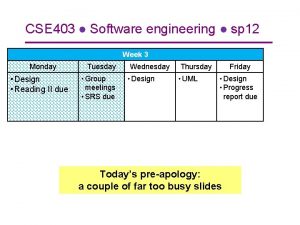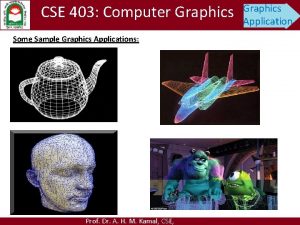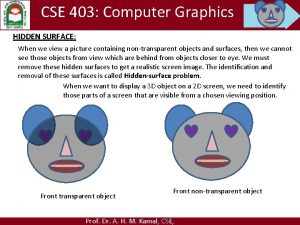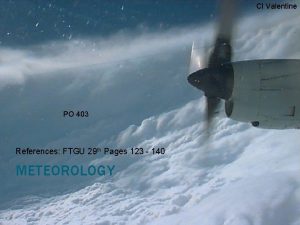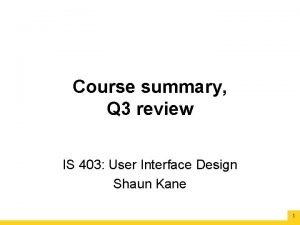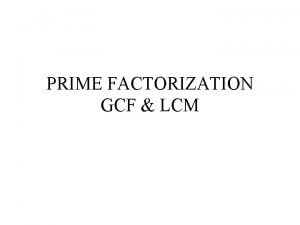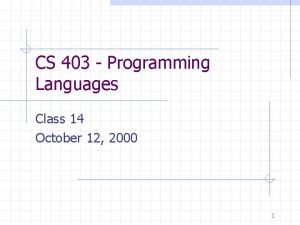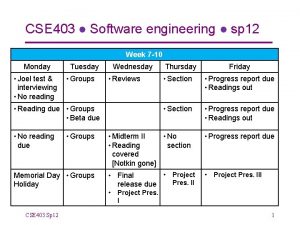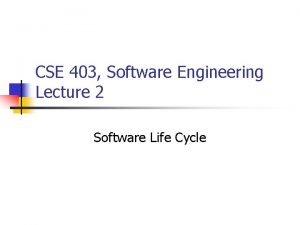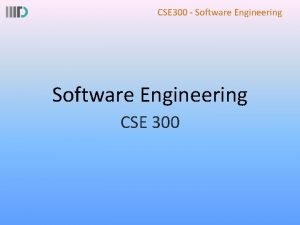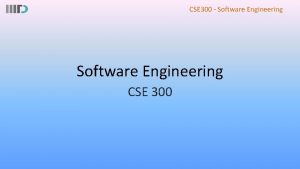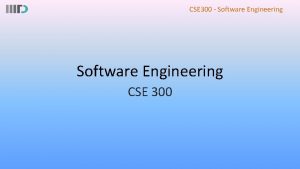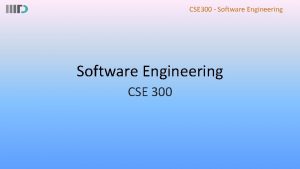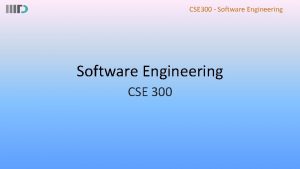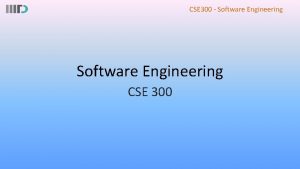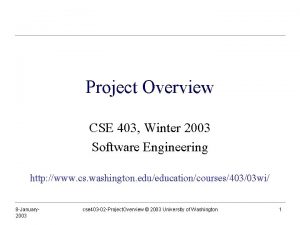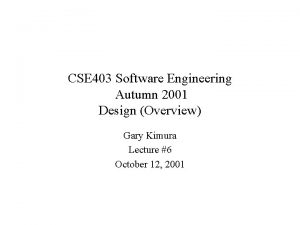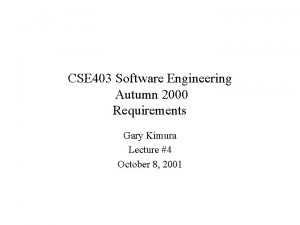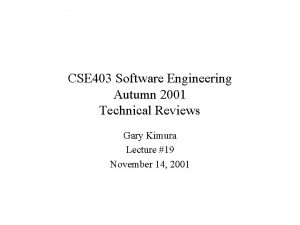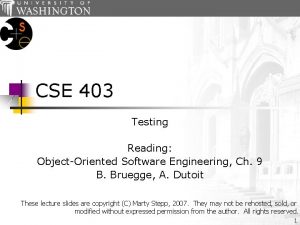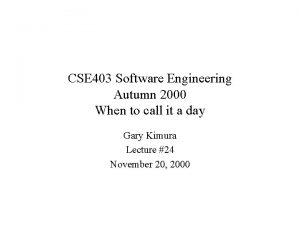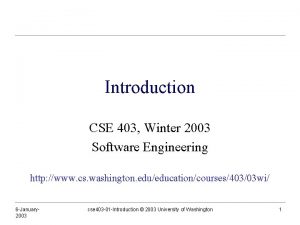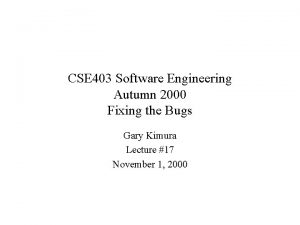CSE 403 Software engineering sp 12 Week 3










![Abstraction Kramer, CACM 2007 • “…[remove] detail to simplify and focus attention based on Abstraction Kramer, CACM 2007 • “…[remove] detail to simplify and focus attention based on](https://slidetodoc.com/presentation_image_h2/b6b9660cd5f5cfc25c62e21dc8d66b6c/image-11.jpg)









- Slides: 20

CSE 403 ● Software engineering ● sp 12 Week 3 Monday • Design • Reading II due Tuesday • Group meetings • SRS due Wednesday • Design Thursday • UML Friday • Design • Progress report due Design is not just what it looks like and feels like. Design is how it works. –Steve Jobs Apologies in advance: some slides with too much text (read off-line) and a really bad joke

What does this 1 -line shell script do? tr -cs A-Za-z 'n' | tr A-Z a-z | sort } uniq -c | sort -rn | sed ${1}q 1 2 3 4 5 6 tr -cs A-Za-z 'n' | tr A-Z a-z | sort | uniq -c | sort -rn | sed ${1}q Jon Bentley, Don Knuth, and Doug Mc. Ilroy. 1986. Programming pearls: a literate program. Commun. ACM 29, 6 (June 1986), 471 -483. DOI=10. 1145/5948. 315654 CSE 403 Sp 12 1. Make one-word lines by transliterating the complement (-c) of the alphabet into newlines (note the quoted newline), and squeezing out ( -s) multiple newlines. 2. Transliterate upper case to lower case. 3. Sort to bring identical words together. 4. Replace each run of duplicate words with a single representative and include a count (-c). 5. Sort in reverse (-r) numeric (-n) order. 6. Pass through a stream editor; quit (q) after printing the number of lines designated by the script’s first parameter (${1}). 2

Given a text file and an integer k, print the k most common words in the file (and the number of their occurrences) in decreasing frequency. 3

Knuth’s version: literate programming 8 th page

Mc. Iroy’s exposition • • Engineering: “Design under Constraints” A wise engineering solution would produce—or better, exploit— Reuse reusable parts. Very few people can obtain the virtuoso services of Knuth …but old UNIX hands know instinctively how to solve this one in a jiffy. Resources … Everything there—even input conversion and sorting—is programmed monolithically and from scratch. In particular the isolation of words, the handling of punctuation, and the treatment of case distinctions are built in. Even if data-filtering programs for these exact purposes were not at hand, these operations would well be Reuse++ implemented separately: for separation of concerns, for easier development, for piecewise debugging, and for potential reuse. The simple pipeline given above will suffice to get answers right now, not next week or next month. It could well be enough to finish the job. But even for a production project, say for the Library of Congress, it would make a handsome down payment, useful for testing the value of the answers and for smoking out follow-on questions. Process CSE 403 Sp 12 5

Challenger Disaster: Feynman The usual way that such engines are designed … may be called the component system, or bottom-up design. First it is necessary to thoroughly understand the properties and limitations of the materials to be used (for turbine blades, for example), and tests are begun in experimental rigs to determine those. With this knowledge larger component parts … are designed and tested individually. As deficiencies and design errors are noted they are corrected and verified with further testing. … Finally one works up to the final design of the entire engine, to the necessary specifications. There is a good chance, by this time that the engine will generally succeed, or that any failures are easily isolated analyzed because the failure modes, limitations of materials, etc. , are so well understood. … Roughly, build bottom-up with components with known properties CSE 403 Sp 12 6

The Space Shuttle Main Engine was handled in a different manner, top down, we might say. The engine was designed and put together all at once with relatively little detailed preliminary study of the material and components. Then when troubles are found in the bearings, turbine blades, coolant pipes, etc. , it is more expensive and difficult to discover the causes and make changes. For example, cracks have been found in the turbine blades of the high pressure oxygen turbopump. Are they caused by flaws in the material, the effect of the oxygen atmosphere on the properties of the material, thermal stresses of startup or shutdown, … or mainly at some resonance at certain speeds, etc. ? … Using the completed engine as a test bed to resolve such questions is extremely expensive. One does not wish to lose an entire engine in order to find out where and how failure occurs. Yet, an accurate knowledge of this information is essential to acquire a confidence in the engine reliability in use. … A further disadvantage of the top-down method is that, if an understanding of a fault is obtained, a simple fix, such as a new shape for the turbine housing, may be impossible to implement without a redesign of the entire engine.

The point? • Software design – like all engineering design – has a set of dimensions and criteria to consider – Correctness, cost, performance, robustness, usability, understandability, modifiability, … – Some of these properties come directly from parts of the software system – Others are more properties of the overall system, sometimes called emergent properties • These are constraints that, in part, distinguish software engineering from theoretical foundations of computation – that work is critical, and software engineering augments it with constraints • Underlying all effective software design – indeed, computational thinking – is the notion of abstraction CSE 403 Sp 12 8

C o n t i n u o u s i t e r a t i v e Continuous & iterative • High-level (“architectural”) design – What pieces? – How connected? • Low-level design – Should I use a hash table or binary search tree? • Very low-level design – Variable naming, which language constructs, etc. – Boolean Zen – About 1000 design decisions at various levels are made in producing a single page of code CSE 403 Sp 12 9

A few key criteria for software design • Accommodating change – taking advantage of software’s “soft”ness – Agile Manifesto; “Software that does not change becomes useless over time” [Belady & Lehman]; … • Generality vs. performance – In math, a more general theorem is always better than a less general one – In software, a less general solution may consume enough fewer resources to dominate a more general solution – but don’t forget #1 • Complexity – physical properties constrain physical design, but fewer constraints are imposed by software as a material CSE 403 Sp 12 10
![Abstraction Kramer CACM 2007 remove detail to simplify and focus attention based on Abstraction Kramer, CACM 2007 • “…[remove] detail to simplify and focus attention based on](https://slidetodoc.com/presentation_image_h2/b6b9660cd5f5cfc25c62e21dc8d66b6c/image-11.jpg)
Abstraction Kramer, CACM 2007 • “…[remove] detail to simplify and focus attention based on the definitions: – The act of withdrawing or removing something, and; – The act or process of leaving out of consideration one or more properties of a complex object so as to attend to others. • “…the process of generalization to identify the common core or essence based on the definitions: – The process of formulating general concepts by abstracting common properties of instances, and; – A general concept formed by extracting common features from specific examples. ” CSE 403 Sp 12 11

Computational thinking Wing, CACM 2006 • “Computational thinking is using abstraction and decomposition when attacking a large complex task or designing a large complex system. It is separation of concerns. It is choosing an appropriate representation for a problem or modeling the relevant aspects of a problem to make it tractable. It is using invariants to describe a system's behavior succinctly and declaratively. It is having the confidence we can safely use, modify, and influence a large complex system without understanding its every detail. It is modularizing something in anticipation of multiple users or prefetching and caching in anticipation of future use. • “Thinking like a computer scientist means more than being able to program a computer. It requires thinking at multiple levels of abstraction…” CSE 403 Sp 12 12

Mechanisms for abstraction? • Methods • Classes In small groups list other software abstraction mechanisms o minutes CSE 403 Sp 12 13

Decomposition and composition • The technique of mastering complexity has been known since ancient times: Divide et impera —Dijkstra, 1965 – …strategy of gaining and maintaining power by breaking up larger concentrations of power into chunks that individually have less power than the one implementing the strategy. —Wikipedia, today • Divide and conquer. Separate your concerns. Yes. But sometimes the conquered tribes must be reunited under the conquering ruler, and the separated concerns must be combined to serve a single purpose. ” —M. Jackson, 1995 CSE 403 Sp 12 14

Benefits of decomposition • • Decrease size of tasks Support independent testing and analysis Separate work assignments Ease understanding • In principle, can significantly reduce paths to consider by introducing an interface – Consider the Knuth and Mc. Ilory examples – Many more… CSE 403 Sp 12 15

Alan Perlis quotations: abstraction • If you have a procedure with 10 parameters, you probably missed some. • One man's constant is another man's variable. • Simplicity does not precede complexity, but follows it. – Our designs are so complex there is no hope of getting them right first time by pure thought. To expect to is arrogant. —Brooks CSE 403 Sp 12 16

Anticipating change & design • It is generally believed that to accommodate change one must anticipate possible changes – Counterpoint: Extreme Programming • By anticipating (and perhaps prioritizing) changes, one defines additional criteria for guiding the design activity – what abstractions one should choose • It is not possible to anticipate all changes Anticipating vs. not anticipating: comments? Extra credit CSE 403 Sp 12 17

KWIC: “hello world” of module design The KWIC index system accepts an ordered set of lines; each line is an ordered set of words, and each word is an ordered set of characters. Any line may be “circularly shifted” by repeatedly removing the first word and appending it at the end of the line. The KWIC index system outputs a list of all circular shifts of all lines in alphabetical order. CSE 403 Sp 12 18

Another script… awk '{print $0 for (i = length($0); i > 0; i--) if (substr($0, i, 1) == " ") print substr($0, i+1) "t" substr($0, 1, i-1) }' $1 | sort -f | awk ' BEGIN {FS = "t"; WID = 30} {printf("%" WID "s %sn", substr($2, length($2)-WID+1), substr($1, 1, WID)) }' • Why not always the best? • What might change? • More in lecture and in Reading III CSE 403 Sp 12 19

CSE 403 ● Software engineering ● sp 12 Week 3 Monday • Design • Reading II due Tuesday • Group meetings • SRS due Wednesday • Design Thursday • UML Friday • Design • Progress report due
 Cse 403
Cse 403 Cse 403
Cse 403 Cse 403
Cse 403 Po 403
Po 403 Medium voltage range
Medium voltage range Envirobond 403
Envirobond 403 403
403 Quantas prendas a turma 403 já levou para a escola
Quantas prendas a turma 403 já levou para a escola 75 lcm
75 lcm Envoy 403b
Envoy 403b Navair 00-25-403
Navair 00-25-403 Cs 403
Cs 403 Week by week plans for documenting children's development
Week by week plans for documenting children's development What is system in software engineering
What is system in software engineering Forward engineering in software engineering
Forward engineering in software engineering Software maintenance process models ppt
Software maintenance process models ppt Who invented software engineering
Who invented software engineering Metrics computer science
Metrics computer science Example of software crisis
Example of software crisis Software metrics example
Software metrics example Real time software design in software engineering
Real time software design in software engineering
